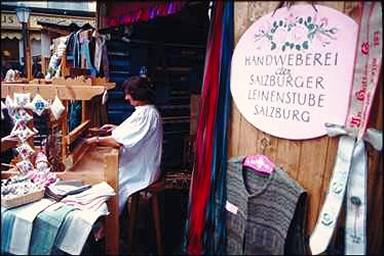It is thought that the first looms, called warp-weighted looms, were vertical structures. The weaver would suspend fibers from a tree branch, which was parallel to the ground, or he might fashion a vertical loom using tree limbs and branches. Below is an image of a warp-weighted loom depicted on a terra cotta Greek vase. The picture gives us clear information about early loom construction, tools used, and weaving processes.
 Ex. 3. Terra cotta vase; Greek, 560 B.C.E.
Ex. 3. Terra cotta vase; Greek, 560 B.C.E.
Warp ends were tied over the top branch and were then placed under tension with stones or weights made of baked clay. Initially, weaving was accomplished by walking back and forth in front of the loom, lifting one warp thread at a time, and passing the weft under and over the warps from side-to-side. Working against gravity, wefts were pushed up into place with the weaver's hands or with a crude comb. Since every warp thread had to be lifted by hand, the process was slow and tedious. In time, a large tapered stick was introduced and was used to carry the weft across the warp and to push, or beat, the threads up into place. Early on, this stick resembled an over-sized needle, but ultimately, it became the shuttle, a tapered device on which weft yarn is wound and which passes between warp threads.
One of the most useful discoveries during the evolution of weaving was the realization of the shed, an opening in the warp through which the weft thread travels, resulting in a web. Initially, weavers had to raise every warp thread by hand and then pass the weft thread through bit by bit, but in time, weavers found ways to create sheds. One such way involved the insertion of a rod under every other warp thread. The rod, called the shed stick, could then be lifted or turned on its side, revealing a clear passage for the weft. The creation of the shed hastened weaving time, but the weaver still had to continually use one hand to hold up the rod in order to pass the shuttle through the shed.

 Ex. 3. Terra cotta vase; Greek, 560 B.C.E.
Ex. 3. Terra cotta vase; Greek, 560 B.C.E.